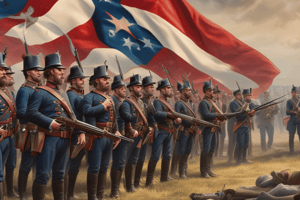Podcast
Questions and Answers
What primarily motivated the younger generation of union members in the 1950s?
What primarily motivated the younger generation of union members in the 1950s?
- Desire for socialist reforms
- Belief in traditional labor practices
- Desire for economic prosperity and higher wages (correct)
- Interest in pre-war union strategies
What characterized the leadership styles of Vic Feather and Len Murray in relation to their members?
What characterized the leadership styles of Vic Feather and Len Murray in relation to their members?
- They led in a detached manner, often unaware of members' realities. (correct)
- They frequently consulted with rank-and-file members about concerns.
- They actively participated in strikes alongside their members.
- They lived lives that were similar to those of the everyday workers.
How did shop stewards contribute to unionism in the 1960s and 1970s?
How did shop stewards contribute to unionism in the 1960s and 1970s?
- They initiated strikes proactively, often bypassing formal processes. (correct)
- They were primarily concerned with upholding socialist ideologies.
- They focused on fostering amicable relationships with management.
- They organized negotiations without prior strike actions.
What shift in unionism occurred during the post-war period?
What shift in unionism occurred during the post-war period?
What impact did the economic conditions of the 1930s and 1940s have on union leadership?
What impact did the economic conditions of the 1930s and 1940s have on union leadership?
Flashcards
Union Leadership Disconnect
Union Leadership Disconnect
Union leaders were often detached from the everyday lives and needs of their rank-and-file members, leading to different priorities and expectations.
1950s Consumerism
1950s Consumerism
The desire to participate in consumer culture, often by increasing wages, spurred union members.
Shop Steward Power
Shop Steward Power
Shop stewards, who were factory-based union representatives, often initiated strike actions, gaining significant influence.
Militant Shop Stewards
Militant Shop Stewards
Signup and view all the flashcards
Shifting Union Focus
Shifting Union Focus
Signup and view all the flashcards
Study Notes
Union Leadership and Members
- Union leaders like Vic Feather and Len Murray had affluent lifestyles, detached from their members.
- These leaders worked long hours but their experiences differed significantly from the rank and file.
- Union leadership expectations differed from the expectations of rank and file members.
Economic and Social Context
- The 1930s and 1940s were marked by periods of depression, war, and austerity.
- Post-war experiences did not significantly impact union leaders.
- Younger union members were more eager to benefit from the consumer boom of the 1950s.
Shop Stewards and Power
- Shop stewards gained power, building influence within their factories.
- They often took strike action before formal negotiations with senior management.
- Shop stewards' actions challenged established union procedures and management.
Aggressive Confrontational Unions
- The 1960s and 1970s witnessed more aggressive and confrontational union styles.
- Increased shop steward power contributed to this trend.
- The rise in aggressive unions was connected less with socialist ideals and more with the consumer boom.
Consumerism and Worker Expectations
- Workers' desires for better pay to participate in the consumer boom prompted changes.
- The consumerism trend influenced working-class men and women's expectations.
- Working-class individuals wanted pay raises to participate in economic prosperity.
Studying That Suits You
Use AI to generate personalized quizzes and flashcards to suit your learning preferences.



